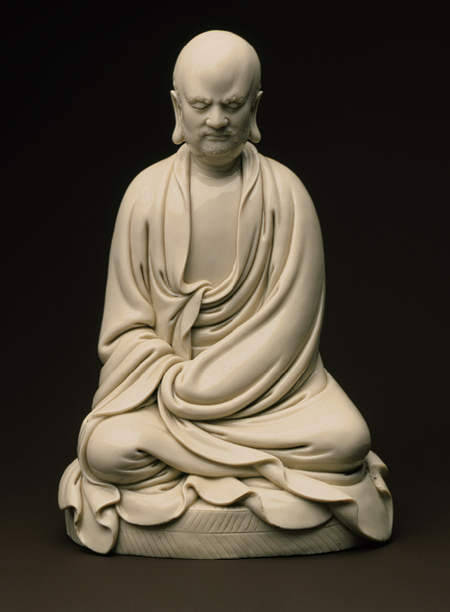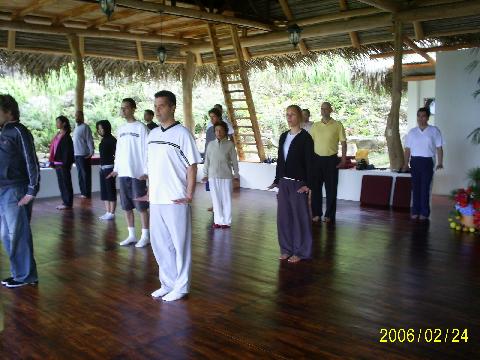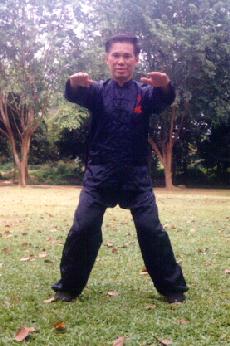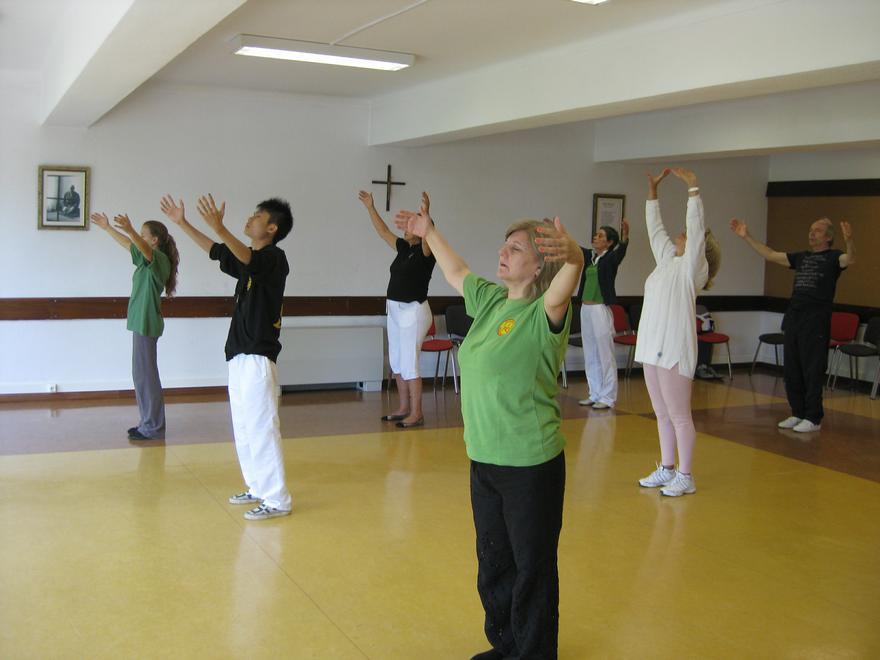SELECTION OF QUESTIONS AND ANSWERS
JUNE 2012 PART 1

Bodhidharma -- picture reproduced from http://vajarayana.wordpress.com/2006/11/20/bodhidharma/
Question 1
Who exactly was Bodhidharma?
— Ahsun, UK
Answer
Bodhidharma was a crown prince in the ancient kingdom of Kanchiporam in present-day India who renounced the throne on his own accord so as to spread the highest spiritual teaching to the East, which is present-day China.
He arrived by sea at Canton, then traveled on land to the capital of the Laing Dynasty in the north to meet the emperor, Liang Wu Ti. When the emperor told Bodhidharm that he (the emperor) had contributed a lot for the spread of Buddhism in his empire and asked what his merits were, Bodhidharma answered that these good deeds brought worldly blessings but for achieving the highest spiritual attainment the emperor had not gained much merit.
Bodhidharma was giving the emperor some excellent advice on the highest spiritual cultivation, but the emperor was not readily for this highest teaching. He asked Bodhidharma who he was, to which the living Boddhisattva replied that he (Bodhidharma) did not know. This was a second change for the emperor to be enlightened, or at least be spiritually awakened, hut again he (the emperor) was not ready. So Bodhidharma left the court and went to the Shaolin Monastery.
Why didn't Emperor Liang Wu Ti have much spiritual merits when he had gained many worldly blessings? In other words, why wasn't Liang Wu Ti close to the highest spiritual attainment when he had done a lot of good deeds?
There is a difference between blessings and merits. Blessings result from doing good deeds, and lead to good karma. In fact Liang Wu Ti had excellent karma, resulting in him being born an emperor. But in terms of spiritual cultivation, he was still far behind. The highest spiritual attainment is Enlightenment, which is a cessation of all karma. Karma leads to rebirth, whereas Enlightenment is the elimination of rebirth.
Of course, this does not mean that we need not cultivate blessings. As long as we wish to have a good life in the phenomenal realm, in this world or in heaven, we must cultivate blessings. But when we wish to attain Enlightenment, which is freeing ourselves from the phenomenal realm, we need to discard blessings and cultivate merits.
Bodhidharma was teaching Liang Wu Ti this invaluable lesson, which many cultivators do not realize. Bodhidharma also gave Liang Wu Ti a second chance when he answered that he did not know who he was. Again, Liang Wu Ti missed this invaluable lesson. Bodhidharma was hinting to Lang Wu Ti that in transcendental Cosmic Realithy there is no differentiation into individual entities.
To help monks at the Shaolin Monastery attain Enlightenment, Bodhidharma taught the Eighteen Lohan Hands and Sinew Metamorphosis. He also taught the skill of Bone Marrow Cleansing as well as Zen meditation to attain Enlightenment in an instance. Later, Eighteen Lohan Hands evolved into Shaolin Kungfu, and Sinew Metamorphosis evolved into Shaolin chi kung. Bodhidharma is honoured as the First Patriarch of the Shaolin arts, namely Zen, chi kung and Shaolin Kungfu.
Question 2
Why did the whole of China bow down to this Indian monk?
Answer
While a lot of people of all races honoured Bodhidharma, not the whole of China bowed to him.
A lot of Chinese did not agree with Bodhidharma's teaching. There was a long tradition of debate between the Taoists and Confucians on one hand and the Buddhists on another.
It is interesting that while many other people mistakenly accuse the Buddhists for not believing in souls, the Confucians accused the Buddhists of creating the concept of souls in after-life to frighten people. The Taoists attacked the Chinese Buddhists for following a foreign religion.
Nevertheless, many Chinese bowed down to Bodhidharma because of his sacrifice and greatness. He sacrificed being a king to teach the highest spiritual lessons to the Chinese and people of all races. His Zen teaching helped many people to be Enlightened.
His teaching of Eighteen Lohan Hands and Sinew Metamorphosis resulted in Shaolin Kungfu being the greatest martial art in the world as well as in bringing good health, vitality, longevity, mental freshness and spiritual joys to countless people irrespective of race, culture and religion.

Flicking Fingers, a powerful exercise from Sinew Metamorphosis
Question 3
What was so special about Bodhidharma?
Answer
Bodhidharma taught us to attain the highest achievement in the supra-mundane level as well as in the mundane level.
Like the Buddha before him, Bodhidharma could be a magnanimous king bringing a lot of benefits for his subjects. But, again like the Buddha before him, he voluntarily renounced kingship to achieve a greater and more noble goal, i.e. bringing spiritual emancipation for people of the world irrespective of race, culture and religion.
It is pertinent to explain that Buddhism as taught by the Buddha, and Zen as taught by Bodhidharma are not religion as normally conceptualized by many people. The Buddha's teaching and Bodhidharma's teaching can benefit people without affecting the people's own chosen religion.
At the supra-mundane level, i.e. beyond the phenomenal world, Bodhidharma's teaching enables us to attain Enlightenment in an instance, called by different people of different cultures as returning to God the Holy Spirit or union with the Supreme Reality.
At the mundane level, i.e. in the phenomenal world, Bodhidharma's teaching enables us to develop a lot of mental clarity and energy so as to attain peak performance in whatever we do in all aspects of our life.
Question 4
A few years ago I met a chi kung master. He taught me some chi kung, but remained very mysterious. I wanted to know if you were familiar with this form.
He told me to be in a high horse stance, and put my fists by my sides, then strike, turning the fist on the very last instant of impact. He kept on emphasizing the importance of turning the fist at the very last instant, that it was imperative that I added speed at the very last moment of impact.
He also stressed that the shoulders should not go forward at all. He asked me to think of yin-yang with one side of my body pulling and the other pushing.
— Adrian, Belgium
Answer
This is "Punching on Horse-Riding Stance", and is a popular training method of many kungfu schools.
Different schools may perform the same exercise differently. In our school we call it "Thirty Punches" because we punch 30 times. It was a standard force-training method for my students in my early years of teaching, but now we use other methods.
We perform this exercise at our normal Horse-Riding Stance, not at a high stance. We do not turn our fists at the last moment, but start turning it at the beginning. However the turning of the fist is gradual, so that it is fully turned only at the end. This gives the punches spiral force.
We do not necessarily increase speed at the last instant. Initially we keep a uniform speed throughout the punch. We usually start slowly, then gradually increase our speed, but the speed of each punch is quite uniform throughout. Later when we are quite proficient, we may vary the speed of each punch, or vary the speed at different parts of a punch.
In our method, the force of the punch does not come from the fist itself, but from our dan tian, or abdominal energy field. The energy flow, which gives the force of the punch, goes through five "gates" -- dan tian, shoulder, elbow, wrist and fist. Hence, it is important not to move the shoulders forward while punching, otherwise this may interrupt the flow of energy to the fist.
The pulling-pushing aspect you mentioned is also not applicable in our method. We keep our body still while punching. Hence, the yin-yang dimension in our method is not the pulling-pushing aspect of the body, but the stillness of the body in contrast with the agility of the punch.

Lifting Water demonstrated by Sifu Wong
Question 5
Can you please tell me more about Lifting Water
— Baron, Netherlands
Answer
Lifting Water is an effective exercise to develop internal force, and is popularly used in Taijiquan. Indeed, it is so popular that most Taijiquan sets start with Lifting Water, though practitioners performing the sets normally perform only two repetitions of Lifting Water instead of many times.
Not many people realize that Lifting Water is also found in Shaolin Kungfu. In my Golden Bell training, Lifting Water was an important part of the training procedure.
In practicing Lifting Water, a practitioner sits at a Goat Stance, and lifts both his arms, palms facing down, from thigh level to chest level numerous times, which may range from a few times to more than a hundred, depending on his aspirations and developmental stage.
He may breathe in gently through the nose when lifting up his arms, and breathe out gently through his mouth when lowering his arms. Or he may perform the exercise without worrying about his breathing.
As it is an internal art exercise, it is advisable to practice it under the supervision of a competent teacher.
Question 6
I'm confused about the practice of chi kung. I have read that it is essential that chi kung is practiced daily to receive the full benefit.
— Harry. England
Answer
Yes, it is essential to practice chi kung daily to receive the full benefit. Preferably one should practice twice a day, once in the morning and once in the evening or at night.
The benefit for each practice is little, so it is necessary to accumulate the effect every day so that the little daily benefit can be added up to be quite a substantial benefit over a period of time, say six months. If one practices irregularly, he (or she) will miss this important aspect of accumulated effect.
The progress must also be gradual. In other words, a practitioner should add just a little benefit each day. If the benefit is too much, it is over-training. Over-training once a while is alright. But over-training over a period of time, or excessive over-training even once, is harmful.
How does one knows it is over-training. He will know from direct experience, just as he will know if he over eats. He will feel uncomfortable, tired and sometimes painful.
The above explanation applies to chi kung in general. But if the chi kung exercise is very powerful, like some advanced chi kung and some methods of internal force training such as Cosmic Breathing and Iron-Wire, even practicing once a day may be over-training for some people.
Whether one over-trains or not, is relative. In other words, the same exercise may be over-training for some people but not for others. Advanced practitioners and masters can practice Cosmic Breathing and Iron-Wire everyday, but not beginners. It is important that one must learn such powerful exercises from a competent teacher.

Accumulated effect is an essential aspect of chi kung training
Question 7
I have also read elsewhere that one should not practice chi kung 24 hours before or after sex as it is harmful to the body,
Answer
This is an interesting and important topic.
The advice is generally true for most types of chi kung and for most people. However, the advice may not apply in certain situations, which I shall explain.
The rationale is that enjoying sex needs energy, and chi kung is an art that develops energy. When you comprehend this rationale, which includes two facts, you will better understand the different situations when and why this advice applies or does not apply.
Most types of chi kung practiced today is actually not genuine chi kung, it is just gentle physical exercise using chi kung forms. Understandably, some people may be angry at this statement, but we in Shaolin Wahnam are not afraid to state the fact for people earnest to find out the truth.
The crucial difference between genuine chi kung and gentle physical exercise is that chi kung works on energy, whereas physical exercise works on the physical body. If one has no experience of energy, or chi, or does not know what working on energy means, then it is most probable that he practices gentle physical exercise though he honestly think it is chi kung.
Another good way to tell the difference is that one has more energy after a chi kung session, whereas one has less energy after a session of physical exercise.
Among those who practice genuine chi kung, the level of chi kung is generally low. Again, some people may be angry at this statement, but we have to state the truth to explain things clearly.
A good way to tell the difference between low-level chi kung and high-level chi kung is that the amount of energy gained in low-level chi kung in a training session is little, whereas the amount of energy gained in high-level chi kung is a lot.
For example, a practitioner of low-level chi kung has to practice for many months before he can feel an increase of energy in him, whereas a practitioner of high-level chi kung can feel an unmistakable increase of energy immediately.
As enjoying sex needs much energy, the amount of energy a person gets from practicing low-level chi kung, or worse, from practicing gentle physical exercise, is not sufficient to meet this demand of energy from sex.
Thus, it is only wise for him to rest for 24 hours before and after sex so that his body has time to be replenished with energy. This applies to most people, as it is a fact that not many people have the opportunity to practice high-level chi kung.
For the privileged few who practice high-level chi kung, the situations are different. If they have not learnt good control of chi flow yet, and if they and their sex partners have patience, they should wait for about an hour after a chi kung practice before they have sex.
This is because, the sex act, while highly pleasurable, can drain a lot of energy. If they have sex immediately after a high-level chi kung practice, a lot of energy will be drained away.
If they and their sex partners can wait for an hour, the discharge, which still provides much pleasure, becomes normal, which they can readily afford. If they or their partners cannot wait for an hour, at least wait for 15 minutes.
They can, in fact should, practice chi kung immediately after sex. But the chi kung exercise should be gentle, like some gentle chi flow, and should not be powerful. This will quickly replenish the energy used in the sex act.
The above advice applies to male practitioners. Female practitioners use a different set of advice. They can have sex immediately after chi kung if they want. They need not practice any gentle chi kung after sex. They just lie there blissfully letting the energy just received spread all over their body.
However, those who have learnt good control of chi flow, both male and female, can have sex immediately after a chi kung session. Of course they can also choose to wait a while if they want. During sex they can let their chi flow harmoniously, so that whatever energy spent in the sex act can be replenished from the Cosmos immediately.
Question 8
If I want to practice chi kung properly do I have to abstain from sex because even regular practice of chi kung would be difficult if I were to have sex only twice a week?
Answer
No, you don't have to abstain from sex if you enjoy it. You can have sex more than twice a week if you want.
But some masters actually ask their students not to have sex at all, as well as not to take sugar, drink coffee or eat certain food. To us this is ridiculous. If one can do wholesome things before practicing chi kung without harming himself and others, not only he can continue doing those things after practicing chi kung, but he should be able to do them with better results.
Indeed, although we do not often highlight it, many of our students, male as well as female, have reported that having learnt high-level chi kung from us, not only they can have sex more often, they also have longer and more enjoyment in their performance.
LINKS
Selected Reading
- Iron Wire Force in Healing and Everyday Life Compared to Other Types of Force
- Practical Programme for Bone Marrow Cleasing
- From 30% to 95% Chance of Winning Free Sparring Competitions
- Combat Sequences to Train Spontaneous Attacks and Responses
- Beautiful Places
